-
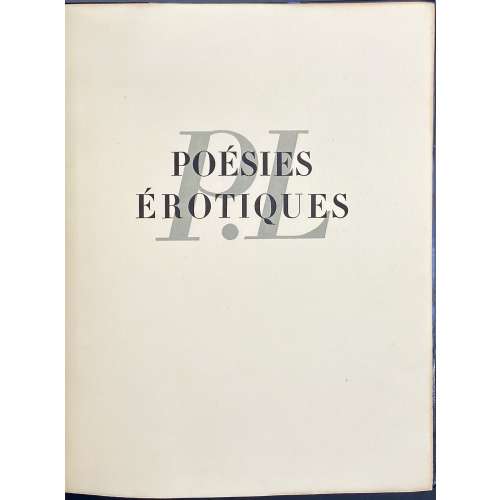 Hardcover volume, 26.6 x 21.3 cm, ¾ blue crushed morocco over marbled boards, marbled endpapers, original wrappers preserved, raised bands; wove paper, watermarked Van Gelder Zonen, unpaginated, 2 ffl, 1 front cover, 2 blanks, 1 h.t., 1 t.p., 46 leaves of text and plates (18 full-page and 14 half-page lithographs by Marcel Vertès), 1 colophon, 1 blank, 1 back cover, 2 ffl; 52 leaves within the original covers, as per Dutel. Title-page: POÉSIES | ÉROTIQUES | D' | UN | AUTE | UR CÉ | LÈBRE, | ILLUSTRÉ | ES DE TR | ENTE-DEUX | LITHOGRAPHIES | ORIGINALES | DESSINÉES | PAR UN | ARTISTE | INCON | NU | ★ | BARCELONE | ATARAZANAS (BARRIO CHINO) | L'AN I DE LA RÉPUBLIQUE | CATALANE || Limitation: A print run of 165 numbered copies, of which this is copy № 148, and 5 additional presentation copies. The text was printed by Massol, and plates were produced by Mme Duchatel. Catalogue raisonné: Dutel III № 2228 ; Nordmann II (Christie’s) № 321; Éros invaincu № 92, p. 222; Vokaer № 36, p. 16. Contributors: Pierre Louÿs (French, 1870 – 1925) – author. Marcel Vertès [Marcell Vértes] (Jewish-Hungarian-French, 1895 – 1961) – artist. René Bonnel (French, 1884 – 1975) – publisher.
Hardcover volume, 26.6 x 21.3 cm, ¾ blue crushed morocco over marbled boards, marbled endpapers, original wrappers preserved, raised bands; wove paper, watermarked Van Gelder Zonen, unpaginated, 2 ffl, 1 front cover, 2 blanks, 1 h.t., 1 t.p., 46 leaves of text and plates (18 full-page and 14 half-page lithographs by Marcel Vertès), 1 colophon, 1 blank, 1 back cover, 2 ffl; 52 leaves within the original covers, as per Dutel. Title-page: POÉSIES | ÉROTIQUES | D' | UN | AUTE | UR CÉ | LÈBRE, | ILLUSTRÉ | ES DE TR | ENTE-DEUX | LITHOGRAPHIES | ORIGINALES | DESSINÉES | PAR UN | ARTISTE | INCON | NU | ★ | BARCELONE | ATARAZANAS (BARRIO CHINO) | L'AN I DE LA RÉPUBLIQUE | CATALANE || Limitation: A print run of 165 numbered copies, of which this is copy № 148, and 5 additional presentation copies. The text was printed by Massol, and plates were produced by Mme Duchatel. Catalogue raisonné: Dutel III № 2228 ; Nordmann II (Christie’s) № 321; Éros invaincu № 92, p. 222; Vokaer № 36, p. 16. Contributors: Pierre Louÿs (French, 1870 – 1925) – author. Marcel Vertès [Marcell Vértes] (Jewish-Hungarian-French, 1895 – 1961) – artist. René Bonnel (French, 1884 – 1975) – publisher. -
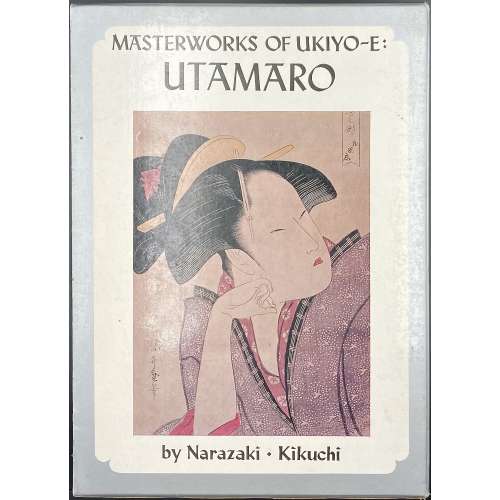 Hardcover volume from the series Masterworks of ukiyo-e, 26.5 x 19 cm, bound in unprimed canvas, red ms characters on black strip to front, red and black lettering to spine, tan embossed endpapers, in a pictorial slipcase with series design (black lettering on silver spine); pp: [1-6]: h.t./frontis. (colour plate pasted in), t.p./imprint, contents/acknowledgements), 7-31 text, [32] blank, 33-96 (76 plates w/captions). Title-page (in frame): MASTERWORKS OF UKIYO-E | UTAMARO | by Muneshige Narazaki and Sadao Kikuchi | Translated by John Bester | {publisher’s device} | KODANSHA INTERNATIONAL LTD. | Tokyo, Japan & Palo-Alto, Calif., U.S.A | {vertical, between rules 歌麿} || Series: Masterworks of ukiyo-e, № 4. Contributors: Muneshige Narazaki [楢崎 宗重] (Japanese, 1904 – 2001) – author. Sadao Kikuchi [菊地 貞雄] (Japanese, 1924 – 2017) – author. John Bester (British, 1927 – 2010) – translator. Kitagawa Utamaro [喜多川 歌麿] (Japanese, c. 1753 – 1806) – artist.
Hardcover volume from the series Masterworks of ukiyo-e, 26.5 x 19 cm, bound in unprimed canvas, red ms characters on black strip to front, red and black lettering to spine, tan embossed endpapers, in a pictorial slipcase with series design (black lettering on silver spine); pp: [1-6]: h.t./frontis. (colour plate pasted in), t.p./imprint, contents/acknowledgements), 7-31 text, [32] blank, 33-96 (76 plates w/captions). Title-page (in frame): MASTERWORKS OF UKIYO-E | UTAMARO | by Muneshige Narazaki and Sadao Kikuchi | Translated by John Bester | {publisher’s device} | KODANSHA INTERNATIONAL LTD. | Tokyo, Japan & Palo-Alto, Calif., U.S.A | {vertical, between rules 歌麿} || Series: Masterworks of ukiyo-e, № 4. Contributors: Muneshige Narazaki [楢崎 宗重] (Japanese, 1904 – 2001) – author. Sadao Kikuchi [菊地 貞雄] (Japanese, 1924 – 2017) – author. John Bester (British, 1927 – 2010) – translator. Kitagawa Utamaro [喜多川 歌麿] (Japanese, c. 1753 – 1806) – artist. -
 Hardcover volume, 23 x 15 cm, bound in full pictorial olive cloth, lettering to spine, in a green slipcase 23.5 x 15.9 cm; pp.: [1-4] 5- 267 [268] [4 blanks], b/w tailpieces, frontispiece and 8 colour photomechanical plates after John Holder. Title-page: GRAHAM GREENE | TRAVELS WITH MY AUNT | A Novel | Introduced by John Mortimer | Illustrated by John Holder | FOLIO SOCIETY | LONDON MMIV || Contributors: Graham Greene (British, 1904 – 1991) – author. John Mortimer (British, 1923 – 2009) – author/introduction. John Holder (British, b. 1941) – artist. St. Edmundsbury Press (UK) – printer. Hunter & Fouls (Haddington) – binder. Folio Society (UK) – publisher. For the 1st edition, see [LIB-2758.2021] Graham Greene. Travels with my aunt: a novel. — London: Bodley Head, 1969.
Hardcover volume, 23 x 15 cm, bound in full pictorial olive cloth, lettering to spine, in a green slipcase 23.5 x 15.9 cm; pp.: [1-4] 5- 267 [268] [4 blanks], b/w tailpieces, frontispiece and 8 colour photomechanical plates after John Holder. Title-page: GRAHAM GREENE | TRAVELS WITH MY AUNT | A Novel | Introduced by John Mortimer | Illustrated by John Holder | FOLIO SOCIETY | LONDON MMIV || Contributors: Graham Greene (British, 1904 – 1991) – author. John Mortimer (British, 1923 – 2009) – author/introduction. John Holder (British, b. 1941) – artist. St. Edmundsbury Press (UK) – printer. Hunter & Fouls (Haddington) – binder. Folio Society (UK) – publisher. For the 1st edition, see [LIB-2758.2021] Graham Greene. Travels with my aunt: a novel. — London: Bodley Head, 1969. -
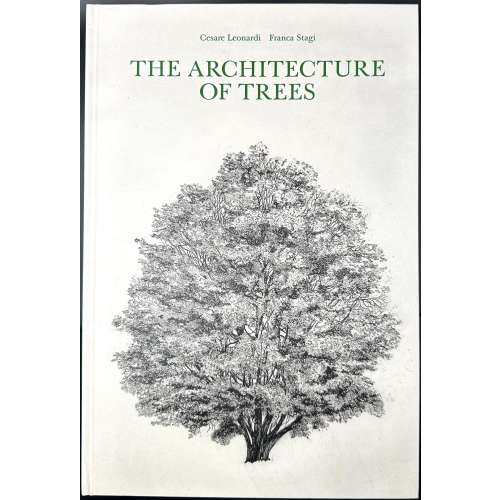 Hardcover volume, 38.3 x 26 x 3.8 cm, pictorial boards, lettering to front cover and spine, pp.: [1-6] 7-421 [3], ils. Title-page: Cesare Leonardi Franca Stagi | THE ARCHITECTURE | OF TREES | Introduction to the new edition | ANDREA CAVANI, GIULIO ORSINI | Translated from the Italian by | NATALIE DANFORD | Princeton Architectural Press | New York || Cesare Leonardi (Italian, 1935 – 2021) Franca Stagi (Italian, 1937 – 2008) Natalie Danford (American, b. 1968)
Hardcover volume, 38.3 x 26 x 3.8 cm, pictorial boards, lettering to front cover and spine, pp.: [1-6] 7-421 [3], ils. Title-page: Cesare Leonardi Franca Stagi | THE ARCHITECTURE | OF TREES | Introduction to the new edition | ANDREA CAVANI, GIULIO ORSINI | Translated from the Italian by | NATALIE DANFORD | Princeton Architectural Press | New York || Cesare Leonardi (Italian, 1935 – 2021) Franca Stagi (Italian, 1937 – 2008) Natalie Danford (American, b. 1968) -
 Title (black and red): ДЖЕЙМС МАКФЕРСОН | ПОЭМЫ ОССИАНА | {device} | ИЗДАНИЕ ПОДГОТОВИЛ | Ю. Д. ЛЕВИН | ИЗДАТЕЛЬСТВО «НАУКА» | ЛЕНИНГРАДСКОЕ ОТДЕЛЕНИЕ | ЛЕНИНГРАД | 1983 || Title verso: РЕДАКЦИОННАЯ КОЛЛЕГИЯ СЕРИИ | «ЛИТЕРАТУРНЫЕ ПАМЯТНИКИ» | (list of names) | Ответственный редактор | академик М. П. АЛЕКСЕЕВ (in frame) | Редактор перевода | Э. Л. ЛИНЕЦКАЯ. Frontispiece (black and red): JAMES MACPHERSON | THE POEMS OF OSSIAN | {device} || Print run: 30,000 copies. Collation: 8vo; [1]8 2-378. Pagination: [1, 2] – serial h.t. / frontis.] [3, 4] – t.p. / editorial board] [portrait / blank] [5, 6] – original t.p. fac-simile / text, 7–589 [590] – imprint, [2] – advert.; 3 leaves of plates. Binding: serial green buckram blind-stamped with a scroll adorned with gold lettering to board and spine. Джеймс Макферсон. Поэмы Оссиана. Ю. Д. Левин. Э. Л. Линецкая.
Title (black and red): ДЖЕЙМС МАКФЕРСОН | ПОЭМЫ ОССИАНА | {device} | ИЗДАНИЕ ПОДГОТОВИЛ | Ю. Д. ЛЕВИН | ИЗДАТЕЛЬСТВО «НАУКА» | ЛЕНИНГРАДСКОЕ ОТДЕЛЕНИЕ | ЛЕНИНГРАД | 1983 || Title verso: РЕДАКЦИОННАЯ КОЛЛЕГИЯ СЕРИИ | «ЛИТЕРАТУРНЫЕ ПАМЯТНИКИ» | (list of names) | Ответственный редактор | академик М. П. АЛЕКСЕЕВ (in frame) | Редактор перевода | Э. Л. ЛИНЕЦКАЯ. Frontispiece (black and red): JAMES MACPHERSON | THE POEMS OF OSSIAN | {device} || Print run: 30,000 copies. Collation: 8vo; [1]8 2-378. Pagination: [1, 2] – serial h.t. / frontis.] [3, 4] – t.p. / editorial board] [portrait / blank] [5, 6] – original t.p. fac-simile / text, 7–589 [590] – imprint, [2] – advert.; 3 leaves of plates. Binding: serial green buckram blind-stamped with a scroll adorned with gold lettering to board and spine. Джеймс Макферсон. Поэмы Оссиана. Ю. Д. Левин. Э. Л. Линецкая. -
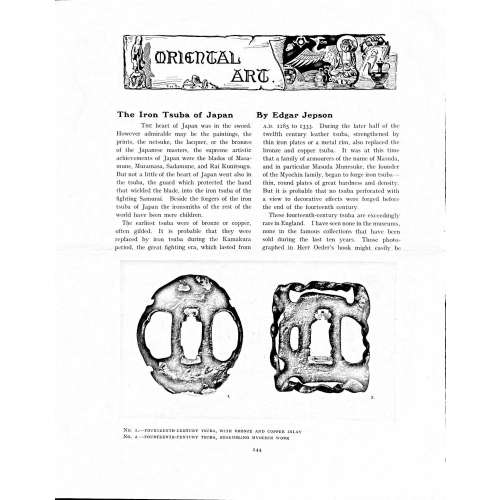 Magazine article by Edgar Jepson: The Iron Tsuba of Japan (Section: Oriental Art), published in volume Vol. 70 (September–December) of The Connoisseur: An Illustrated Magazine for Collectors, Vol. 70 (September–December); pp. 143-152 / C. Reginald Grundy [ed.] — London: Published by the Proprietor, W. CLAUSE JOHNSON, at the Editorial and Advertisement Offices of The Connoisseur, 1924. Owner's half black morocco, gilt lettering to spine, blue cloth boards. Two volumes bound together without original covers. Size 28.5 x 22 cm. Vol. 1: The Connoisseur | An Illustrated Magazine | For Collectors | Edited by C. Reginald Grundy | Vol. LXIX. | (MAY—AUGUST, 1924) | LONDON | Published by the Proprietor, W. CLAUSE JOHNSON, at the | Editorial and Advertisement Offices of The Connoisseur, | at 1, Duke Street, St. James's, S.W. 1 | 1924 || Pp.: [i-ii] iii-xviii [xix] [1, 2 - plate] 3-249 [250]. Vol. 2: The Connoisseur | An Illustrated Magazine | For Collectors | Edited by C. Reginald Grundy | Vol. LXX. | (SEPTEMBER—DECEMBER, 1924) | LONDON | Published by the Proprietor, W. CLAUSE JOHNSON, at the | Editorial and Advertisement Offices of The Connoisseur, | at 1, Duke Street, St. James's, S.W. 1 | 1924 || Pp.: [i-ii] iii-xxii [2 blanks] [1, 2 - plate] 3-261 [262]. The Iron Tsuba of Japan by Edgar Jepson The heart of Japan was in the sword. However admirable may be the paintings, the prints, the netsuke, the lacquer, or the bronzes of the Japanese masters, the supreme artistic achievements of Japan were the blades of Masamune, Muramasa, Sadamune, and Rai Kunitsugu. But not a little of the heart of Japan went also in the tsuba, the guard which protected the hand that wielded the blade, into the iron tsuba of the fighting Samurai. Beside the forgers of the iron tsuba of Japan the ironsmiths of the rest of the world have been mere children. The earliest tsuba were of bronze or copper, often gilded. It is probable that they were replaced by iron tsuba during the Kamakura period, the great fighting era, which lasted from A.D. 1185 to 1333. During the later half of the twelfth century leather tsuba, strengthened by thin iron plates or a metal rim, also replaced the bronze and copper tsuba. It was at this time that a family of armourers of the name of Masuda, and in particular Masuda Munesuke, the founder of the Myochin family, began to forge iron tsuba — thin, round plates of great hardness and density. But it is probable that no tsuba perforated with a view to decorative effects were forged before the end of the fourteenth century. These fourteenth-century tsuba are exceedingly rare in England. I have seen none in the museums, none in the famous collections that have been sold during the last ten years. Those photographed in Herr Oeder's book might easily be the fifteenth century. No. 1 is a curious cup-shape tsuba decorated with a bronze and copper inlay. No. 2, with its edges curiously twisted in the forging, looks like Myochin work. But it is not of the Myochin iron. The Myochin family produced some of the greatest ironsmiths of Japan. Armourers first of all, tsubasmiths, forgers of sake-kettles, articulated reptiles, crustacea, and insects — everything that can be done with iron they did; they pushed their medium to its limit. They were forging iron tsuba in 1160, and they were still forging them in 1860. And it was their own iron, or rather their own steel. They discovered the secret of it early, and they kept that secret in the family for all those hundreds of years. There is no mistaking a Myochin tsuba: balance it on your finger and tap it with a piece of metal, always it gives forth a clear bell-like ring that you get from the work of no other ironsmith, Japanese or European. Always the Myochin tsuba is before everything a protection to the hand of the swordsman; to that everything is, as it should be, subordinated. No. 3 is a Myochin tsuba of the fifteenth century, and probably of the early fifteenth century. No. 4, by Myochin Munetaka, perforated with a grotesque figure, is an example of that twisting and twisting of the iron in the forging till it forms a pattern like the grain of wood. The Myochin smiths invented these wood-grain tsuba, and no other smiths equalled them in their forging. In the sixteenth century, the fighting tsuba was probably at its best. It was a century of great tsubasmiths. Then the first Nobuiye, whose tsuba fetched £100 apiece, circa 1800, in Japan, and the first Kaneiye flourished. No. 5 is a tsuba forged by a great smith, Iyesada of Sotome, in the manner of Nobuiye I, decorated with the karakusa tendrils that Nobuiye delighted in, with lightning and clouds. No. 6 is a guard of Sanada Tembo, the chief smith of the Tembo family, stamped, punning fashion, with the character Tembo. Akin to the Tembo tsuba were those of the Kiami and Hoan smiths. Then also the Heianjo smiths and the Owari smiths, especially those of Nagoya and the Yamakichi family, forged their strongest tsuba. Those of the Yamakichi were tested after the forging by being pounded in iron mortars — at least, so the legend runs. But they were a sternly utilitarian family, and I have never seen a Yamakichi tsuba of any beauty. In the later half of the fifteenth century arose the fashion of decorating tsuba with an inlay, zogan, of bronze. The Heianjo tsuba, forged at Kyoto in the latter half of the fifteenth and the beginning of the sixteenth century, were often thus inlaid. The earliest of them were called "Onin", of which No. 7 is an example. In addition to the bronze inlay around the edge, it is inlaid with a representation, some say, of snow; others say, of the duckweed on a pond. No. 8 is probably a Heianjo tsuba, but I am not quite sure about it. The inlaid acacia branches might be very early Shoami work. But to judge by the iron, it is a fifteenth-century tsuba; and the authorities place the beginning of the Shoami school not later than early in the sixteenth century. No. 10 is an example of the Fushimi-zogan, a flat inlay of a light-coloured bronze. These tsuba took their name from the fact that they were first forged at Fushimi, in Yamashiro, in the sixteenth century. It is of the type known as Mon-zukashi, perforated with crests (mon) à jour. The Yoshiro-zogan tsuba were also first forged at Fushimi by Yoshiro Naomasa. They were distinguished from the Fushimi-zogan by the fact that their inlay was generally a little raised-not always-for the inlay of No. 9, a tsuba forged by a later nineteenth-century Yoshiro, is quite flat. It is an interesting tsuba, for, with its decoration grown florid and excessive, it marks the intermediate stage between the simple and delightful designs of the genuine fighting tsuba and the elaborate pictures in gold and silver on the tsuba of the eighteenth-century smiths of Awa and Kyoto, which have become mere ornaments of the goldsmith. The Gomoku-zogan (No. 11) tsuba were probably first forged earlier than the Fushimi and Yoshiro-zogan tsuba. This inlay, in slight relief, is a representation in a light-coloured bronze and copper of twigs caught in the eddies of streams. The seventeenth century and early eighteenth century were the great periods of perforated tsuba. The designs, and they are often admirable, are for the most part in plain fretwork; but they are also chased. No. 12, a crane under an acacia, is a tsuba of a Higo smith, great forgers of fighting tsuba during this period. These smiths also excelled in nunome zogan, a very thin gold and silver inlay, with which they further decorated their perforated guards. The smiths of the Umetada and Shoami families also forged iron tsuba during this period; but their designs, though sometimes pleasing enough, are rarely fine. The best work of Myoju Umetada is in sentoku, not iron. The Choshu smiths, coming later, surpass the perforated guards of both the Umetada and Shoami smiths in beauty of design. No. 13, a lotus in the round, not only fretwork, but also engraved, is a good example of the admirable balance they so often attained in their designs. It is a sufficiently realistic lotus, but yet of a delightful simplicity. In considerable contrast is No. 14, the dragon by Soheishi Soten — one of the only two authentic tsuba of his forging known — the first forger of hikone-bori tsuba, which were in extraordinary favour in Japan during the eighteenth century, and illustrated every important event in Japanese history. It is on the elaborate side, but fine, strong work, and an excellent guard to the hand, for the lighter and more open part, which gives the design its admirable balance, is on the inside, and not exposed to the full swing of an opponent's blade. A few years ago there was a tendency to decry the Namban tsuba as having sprung too directly from foreign sources. But though the original suggestion may have been Chinese, or, as some say, Portuguese, the Japanese made it entirely their own, as characteristically Japanese as anything can well be, but, it must be admitted, of a decadent period. The school took its rise at the beginning of the seventeenth century, and the early tsuba were forged of a specially hard iron, the Wootz, imported from Southern India. No. 15, the signs of the Zodiac, is an excellent tsuba from the fighting point of view. Both it and No. 16 are of quite charming, if elaborate, design, and both of them, with their delicate scroll-work, so astonishingly undercut, are the very last word in the work of the ironsmith-veritable iron lace. To return to the simpler perforated tsuba, the smiths of Akasaka, a suburb of Tokyo, produced probably the most charming designs. Their style derives considerably from the Higo smiths, and their earlier fighting tsuba are very like the Higo tsuba. But always their work was just a little lighter than that of the Higo smiths, and in the end they moved right away from them and became the forgers of very light guards indeed. No. 17, is a representation of the Hiyokudori, the fabulous double bird, in which were reincarnated the souls of the two lovers, Gompachi and Komurasaki; and No. 18, “the tsuba of a hundred ducks "— there are about forty — are characteristic designs of the school. In the work of the Akasaka smiths the balance, which makes the design of a good tsuba so admirable and delightful, attains its height. This admirable balance seems often to be obtained by a deliberate sacrifice of symmetry. About nine hundred and ninety-nine European ironsmiths out of a thousand would have made the right and left sides of the Hiyoku-dori line by line, and perforation by perforation, exactly alike; he would have cut out exactly as many ducks on the one side of “the tsuba of a hundred ducks” as on the other, and made each duck on the right side correspond exactly in position and attitude with a duck on the left side. By variations the tsubasmith attained a finer balance, almost a higher symmetry. No. 19, often called by collectors the "rose-window" tsuba, but really a stylised chrysanthemum, is a favourite design of the Akasaka smiths, but Hizen work and inlaid in the Hizen manner with gold nunome. No. 20 is a Satsuma tsuba of the middle period. The Satsuma smiths of the nineteenth century produced probably the most ornate of all the iron guards, for the most part calibashes and beans with their leaves and tendrils realistic in the extreme, but of charming design. Few crafts have been carried further than that of the tsubasmith; few crafts working in a difficult medium have handled more subjects with greater feeling for beauty or greater liveliness of fancy. It is interesting to note again and again how school influences school, and smith influences smith. But, as in all the applied arts, the finest tsuba were forged by men who never lost sight of the purpose of a tsuba, that it is before everything a protection to the hand, and never subjected that purpose to a passion for virtuosity. Illustrations: No 1. FOURTEENTH-CENTURY TSUBA, WITH BRONZE AND COPPER INLAY No. 2. FOURTEENTH-CENTURY TSUBA, RESEMBLING MYOCHIN WORK No. 3. MYOCHIN TSUBA, FIFTEENTH CENTURY No. 4. MYOCHIN TSUBA, NINETEENTH CENTURY No. 5. SIXTEENTH-CENTURY TSUBA No. 6. SIXTEENTH-CENTURY TSUBA BY IYESADA OF SOTOME BY SANADA TEMBO No. 7. ONIN TSUBA No. 8. HEIANJO (?) TSUBA No. 9. YOSHIRO TSUBA, NINETEENTH CENTURY No. 10. FUSHIMI-ZOGAN, NINETEENTH CENTURY No. 11.- GOMOKU-ZOGAN, SIXTEENTH CENTURY No. 12. HIGO TSUBA, SEVENTEENTH CENTURY No. 13. CHOSHU TSUBA, SEVENTEENTH CENTURY No. 14. SOTEN TSUBA, SEVENTEENTH CENTURY No. 15. NAMBAN TSUBA, EIGHTEENTH CENTURY No. 16. NAMBAN TSUBA, NINETEENTH CENTURY Nos. 17. AND 18. AKASAKA TSUBA, EIGHTEENTH CENTURY No. 19. HIZEN TSUBA, EIGHTEENTH CENTURY No. 20. SATSUMA TSUBA, EIGHTEENTH CENTURY
Magazine article by Edgar Jepson: The Iron Tsuba of Japan (Section: Oriental Art), published in volume Vol. 70 (September–December) of The Connoisseur: An Illustrated Magazine for Collectors, Vol. 70 (September–December); pp. 143-152 / C. Reginald Grundy [ed.] — London: Published by the Proprietor, W. CLAUSE JOHNSON, at the Editorial and Advertisement Offices of The Connoisseur, 1924. Owner's half black morocco, gilt lettering to spine, blue cloth boards. Two volumes bound together without original covers. Size 28.5 x 22 cm. Vol. 1: The Connoisseur | An Illustrated Magazine | For Collectors | Edited by C. Reginald Grundy | Vol. LXIX. | (MAY—AUGUST, 1924) | LONDON | Published by the Proprietor, W. CLAUSE JOHNSON, at the | Editorial and Advertisement Offices of The Connoisseur, | at 1, Duke Street, St. James's, S.W. 1 | 1924 || Pp.: [i-ii] iii-xviii [xix] [1, 2 - plate] 3-249 [250]. Vol. 2: The Connoisseur | An Illustrated Magazine | For Collectors | Edited by C. Reginald Grundy | Vol. LXX. | (SEPTEMBER—DECEMBER, 1924) | LONDON | Published by the Proprietor, W. CLAUSE JOHNSON, at the | Editorial and Advertisement Offices of The Connoisseur, | at 1, Duke Street, St. James's, S.W. 1 | 1924 || Pp.: [i-ii] iii-xxii [2 blanks] [1, 2 - plate] 3-261 [262]. The Iron Tsuba of Japan by Edgar Jepson The heart of Japan was in the sword. However admirable may be the paintings, the prints, the netsuke, the lacquer, or the bronzes of the Japanese masters, the supreme artistic achievements of Japan were the blades of Masamune, Muramasa, Sadamune, and Rai Kunitsugu. But not a little of the heart of Japan went also in the tsuba, the guard which protected the hand that wielded the blade, into the iron tsuba of the fighting Samurai. Beside the forgers of the iron tsuba of Japan the ironsmiths of the rest of the world have been mere children. The earliest tsuba were of bronze or copper, often gilded. It is probable that they were replaced by iron tsuba during the Kamakura period, the great fighting era, which lasted from A.D. 1185 to 1333. During the later half of the twelfth century leather tsuba, strengthened by thin iron plates or a metal rim, also replaced the bronze and copper tsuba. It was at this time that a family of armourers of the name of Masuda, and in particular Masuda Munesuke, the founder of the Myochin family, began to forge iron tsuba — thin, round plates of great hardness and density. But it is probable that no tsuba perforated with a view to decorative effects were forged before the end of the fourteenth century. These fourteenth-century tsuba are exceedingly rare in England. I have seen none in the museums, none in the famous collections that have been sold during the last ten years. Those photographed in Herr Oeder's book might easily be the fifteenth century. No. 1 is a curious cup-shape tsuba decorated with a bronze and copper inlay. No. 2, with its edges curiously twisted in the forging, looks like Myochin work. But it is not of the Myochin iron. The Myochin family produced some of the greatest ironsmiths of Japan. Armourers first of all, tsubasmiths, forgers of sake-kettles, articulated reptiles, crustacea, and insects — everything that can be done with iron they did; they pushed their medium to its limit. They were forging iron tsuba in 1160, and they were still forging them in 1860. And it was their own iron, or rather their own steel. They discovered the secret of it early, and they kept that secret in the family for all those hundreds of years. There is no mistaking a Myochin tsuba: balance it on your finger and tap it with a piece of metal, always it gives forth a clear bell-like ring that you get from the work of no other ironsmith, Japanese or European. Always the Myochin tsuba is before everything a protection to the hand of the swordsman; to that everything is, as it should be, subordinated. No. 3 is a Myochin tsuba of the fifteenth century, and probably of the early fifteenth century. No. 4, by Myochin Munetaka, perforated with a grotesque figure, is an example of that twisting and twisting of the iron in the forging till it forms a pattern like the grain of wood. The Myochin smiths invented these wood-grain tsuba, and no other smiths equalled them in their forging. In the sixteenth century, the fighting tsuba was probably at its best. It was a century of great tsubasmiths. Then the first Nobuiye, whose tsuba fetched £100 apiece, circa 1800, in Japan, and the first Kaneiye flourished. No. 5 is a tsuba forged by a great smith, Iyesada of Sotome, in the manner of Nobuiye I, decorated with the karakusa tendrils that Nobuiye delighted in, with lightning and clouds. No. 6 is a guard of Sanada Tembo, the chief smith of the Tembo family, stamped, punning fashion, with the character Tembo. Akin to the Tembo tsuba were those of the Kiami and Hoan smiths. Then also the Heianjo smiths and the Owari smiths, especially those of Nagoya and the Yamakichi family, forged their strongest tsuba. Those of the Yamakichi were tested after the forging by being pounded in iron mortars — at least, so the legend runs. But they were a sternly utilitarian family, and I have never seen a Yamakichi tsuba of any beauty. In the later half of the fifteenth century arose the fashion of decorating tsuba with an inlay, zogan, of bronze. The Heianjo tsuba, forged at Kyoto in the latter half of the fifteenth and the beginning of the sixteenth century, were often thus inlaid. The earliest of them were called "Onin", of which No. 7 is an example. In addition to the bronze inlay around the edge, it is inlaid with a representation, some say, of snow; others say, of the duckweed on a pond. No. 8 is probably a Heianjo tsuba, but I am not quite sure about it. The inlaid acacia branches might be very early Shoami work. But to judge by the iron, it is a fifteenth-century tsuba; and the authorities place the beginning of the Shoami school not later than early in the sixteenth century. No. 10 is an example of the Fushimi-zogan, a flat inlay of a light-coloured bronze. These tsuba took their name from the fact that they were first forged at Fushimi, in Yamashiro, in the sixteenth century. It is of the type known as Mon-zukashi, perforated with crests (mon) à jour. The Yoshiro-zogan tsuba were also first forged at Fushimi by Yoshiro Naomasa. They were distinguished from the Fushimi-zogan by the fact that their inlay was generally a little raised-not always-for the inlay of No. 9, a tsuba forged by a later nineteenth-century Yoshiro, is quite flat. It is an interesting tsuba, for, with its decoration grown florid and excessive, it marks the intermediate stage between the simple and delightful designs of the genuine fighting tsuba and the elaborate pictures in gold and silver on the tsuba of the eighteenth-century smiths of Awa and Kyoto, which have become mere ornaments of the goldsmith. The Gomoku-zogan (No. 11) tsuba were probably first forged earlier than the Fushimi and Yoshiro-zogan tsuba. This inlay, in slight relief, is a representation in a light-coloured bronze and copper of twigs caught in the eddies of streams. The seventeenth century and early eighteenth century were the great periods of perforated tsuba. The designs, and they are often admirable, are for the most part in plain fretwork; but they are also chased. No. 12, a crane under an acacia, is a tsuba of a Higo smith, great forgers of fighting tsuba during this period. These smiths also excelled in nunome zogan, a very thin gold and silver inlay, with which they further decorated their perforated guards. The smiths of the Umetada and Shoami families also forged iron tsuba during this period; but their designs, though sometimes pleasing enough, are rarely fine. The best work of Myoju Umetada is in sentoku, not iron. The Choshu smiths, coming later, surpass the perforated guards of both the Umetada and Shoami smiths in beauty of design. No. 13, a lotus in the round, not only fretwork, but also engraved, is a good example of the admirable balance they so often attained in their designs. It is a sufficiently realistic lotus, but yet of a delightful simplicity. In considerable contrast is No. 14, the dragon by Soheishi Soten — one of the only two authentic tsuba of his forging known — the first forger of hikone-bori tsuba, which were in extraordinary favour in Japan during the eighteenth century, and illustrated every important event in Japanese history. It is on the elaborate side, but fine, strong work, and an excellent guard to the hand, for the lighter and more open part, which gives the design its admirable balance, is on the inside, and not exposed to the full swing of an opponent's blade. A few years ago there was a tendency to decry the Namban tsuba as having sprung too directly from foreign sources. But though the original suggestion may have been Chinese, or, as some say, Portuguese, the Japanese made it entirely their own, as characteristically Japanese as anything can well be, but, it must be admitted, of a decadent period. The school took its rise at the beginning of the seventeenth century, and the early tsuba were forged of a specially hard iron, the Wootz, imported from Southern India. No. 15, the signs of the Zodiac, is an excellent tsuba from the fighting point of view. Both it and No. 16 are of quite charming, if elaborate, design, and both of them, with their delicate scroll-work, so astonishingly undercut, are the very last word in the work of the ironsmith-veritable iron lace. To return to the simpler perforated tsuba, the smiths of Akasaka, a suburb of Tokyo, produced probably the most charming designs. Their style derives considerably from the Higo smiths, and their earlier fighting tsuba are very like the Higo tsuba. But always their work was just a little lighter than that of the Higo smiths, and in the end they moved right away from them and became the forgers of very light guards indeed. No. 17, is a representation of the Hiyokudori, the fabulous double bird, in which were reincarnated the souls of the two lovers, Gompachi and Komurasaki; and No. 18, “the tsuba of a hundred ducks "— there are about forty — are characteristic designs of the school. In the work of the Akasaka smiths the balance, which makes the design of a good tsuba so admirable and delightful, attains its height. This admirable balance seems often to be obtained by a deliberate sacrifice of symmetry. About nine hundred and ninety-nine European ironsmiths out of a thousand would have made the right and left sides of the Hiyoku-dori line by line, and perforation by perforation, exactly alike; he would have cut out exactly as many ducks on the one side of “the tsuba of a hundred ducks” as on the other, and made each duck on the right side correspond exactly in position and attitude with a duck on the left side. By variations the tsubasmith attained a finer balance, almost a higher symmetry. No. 19, often called by collectors the "rose-window" tsuba, but really a stylised chrysanthemum, is a favourite design of the Akasaka smiths, but Hizen work and inlaid in the Hizen manner with gold nunome. No. 20 is a Satsuma tsuba of the middle period. The Satsuma smiths of the nineteenth century produced probably the most ornate of all the iron guards, for the most part calibashes and beans with their leaves and tendrils realistic in the extreme, but of charming design. Few crafts have been carried further than that of the tsubasmith; few crafts working in a difficult medium have handled more subjects with greater feeling for beauty or greater liveliness of fancy. It is interesting to note again and again how school influences school, and smith influences smith. But, as in all the applied arts, the finest tsuba were forged by men who never lost sight of the purpose of a tsuba, that it is before everything a protection to the hand, and never subjected that purpose to a passion for virtuosity. Illustrations: No 1. FOURTEENTH-CENTURY TSUBA, WITH BRONZE AND COPPER INLAY No. 2. FOURTEENTH-CENTURY TSUBA, RESEMBLING MYOCHIN WORK No. 3. MYOCHIN TSUBA, FIFTEENTH CENTURY No. 4. MYOCHIN TSUBA, NINETEENTH CENTURY No. 5. SIXTEENTH-CENTURY TSUBA No. 6. SIXTEENTH-CENTURY TSUBA BY IYESADA OF SOTOME BY SANADA TEMBO No. 7. ONIN TSUBA No. 8. HEIANJO (?) TSUBA No. 9. YOSHIRO TSUBA, NINETEENTH CENTURY No. 10. FUSHIMI-ZOGAN, NINETEENTH CENTURY No. 11.- GOMOKU-ZOGAN, SIXTEENTH CENTURY No. 12. HIGO TSUBA, SEVENTEENTH CENTURY No. 13. CHOSHU TSUBA, SEVENTEENTH CENTURY No. 14. SOTEN TSUBA, SEVENTEENTH CENTURY No. 15. NAMBAN TSUBA, EIGHTEENTH CENTURY No. 16. NAMBAN TSUBA, NINETEENTH CENTURY Nos. 17. AND 18. AKASAKA TSUBA, EIGHTEENTH CENTURY No. 19. HIZEN TSUBA, EIGHTEENTH CENTURY No. 20. SATSUMA TSUBA, EIGHTEENTH CENTURY -
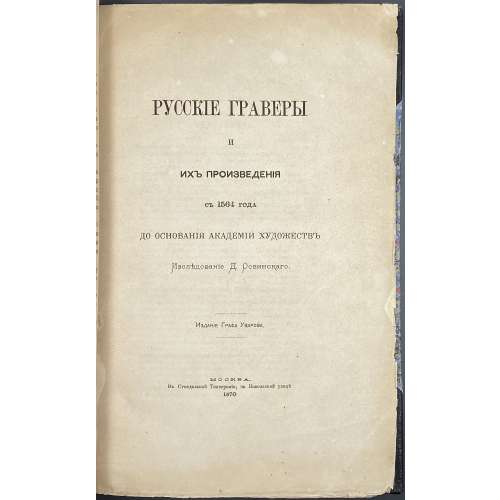 Title: РУССКIЕ ГРАВЕРЫ | И | ИХЪ ПРОИЗВЕДЕНIЯ | СЪ 1564 ГОДА | ДО ОСНОВАНIЯ АКАДЕМIИ ХУДОЖЕСТВЪ. | Изследованiе Д. Ровинскаго. | Изданiе графа Уварова. | МОСКВА. | Въ Сѵнодальной типографiи, на Никольской улицѣ. | 1870. || Pagination: [2] orig. wrapper / advert., [2] t.p. / imp.[i] ii-x, [1] 2-403 [404], [2] orig. wrapper / advert. Collation: 8vo; π6 (incl. t.p.), 1-258 χ2 Binding: Owner’s ½ black morocco over marbled boards, raised bands, gilt-ruled, florets and lettering in compartments, blue endpapers, uncut, untrimmed, original wrappers preserved. Size: 29.5 x 19 cm
Title: РУССКIЕ ГРАВЕРЫ | И | ИХЪ ПРОИЗВЕДЕНIЯ | СЪ 1564 ГОДА | ДО ОСНОВАНIЯ АКАДЕМIИ ХУДОЖЕСТВЪ. | Изследованiе Д. Ровинскаго. | Изданiе графа Уварова. | МОСКВА. | Въ Сѵнодальной типографiи, на Никольской улицѣ. | 1870. || Pagination: [2] orig. wrapper / advert., [2] t.p. / imp.[i] ii-x, [1] 2-403 [404], [2] orig. wrapper / advert. Collation: 8vo; π6 (incl. t.p.), 1-258 χ2 Binding: Owner’s ½ black morocco over marbled boards, raised bands, gilt-ruled, florets and lettering in compartments, blue endpapers, uncut, untrimmed, original wrappers preserved. Size: 29.5 x 19 cm -
![Joseph Burke and Colin Caldwell. Hogarth: The Complete Engravings. – Harry N. Abrams, Inc., Publishers, New York, [1968].](https://varshavskycollection.com/wp-content/uploads/2021/02/LIB-2111.2019-a-scaled-500x500.jpeg) Title: Joseph Burke and Colin Caldwell | Hogarth | The Complete Engravings | Harry N. Abrams, Inc., Publishers, New York || Pagination: [1-4] 5-30 (text), unpaginated: 128 leaves of illustrations (267 plates), 16 leaves of descriptions, folding list of plates: total number of leaves 160, incl. one folding. Exterior: 34 x 24.5 cm, hardbound; original brown cloth, silver lettering to spine, pictorial DJ. Harry N. Abrams (British-American, 1905 – 1979). Joseph Terence Burke (British, 1913 – 1992). Colin Caldwell (British, 1913 – 1989).
Title: Joseph Burke and Colin Caldwell | Hogarth | The Complete Engravings | Harry N. Abrams, Inc., Publishers, New York || Pagination: [1-4] 5-30 (text), unpaginated: 128 leaves of illustrations (267 plates), 16 leaves of descriptions, folding list of plates: total number of leaves 160, incl. one folding. Exterior: 34 x 24.5 cm, hardbound; original brown cloth, silver lettering to spine, pictorial DJ. Harry N. Abrams (British-American, 1905 – 1979). Joseph Terence Burke (British, 1913 – 1992). Colin Caldwell (British, 1913 – 1989). -
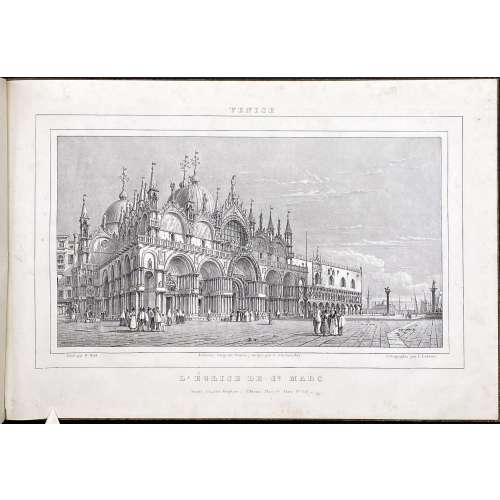 Owner's convolute binding of the period in quarter tan cloth, yellow marbled boards, no title page, no pagination. Contents: (1) Venetian Album –12 lithographs by Émile-Aubert Lessore (French, 1805 – 1876) after William Wyld (British, 1806 – 1889). — Venice: Charles Hopfner, [1834]. Printed at Premiata Litografia Veneta under the direction of Ferdinand Wolfgang Flachenecker (German, 1782 – 1847). Inscription: Premiata Litografia Veneta, dirigée par C. Flachenecker.
Owner's convolute binding of the period in quarter tan cloth, yellow marbled boards, no title page, no pagination. Contents: (1) Venetian Album –12 lithographs by Émile-Aubert Lessore (French, 1805 – 1876) after William Wyld (British, 1806 – 1889). — Venice: Charles Hopfner, [1834]. Printed at Premiata Litografia Veneta under the direction of Ferdinand Wolfgang Flachenecker (German, 1782 – 1847). Inscription: Premiata Litografia Veneta, dirigée par C. Flachenecker.- L'Église de St. Marc
- La place St. Marc
- Le palais Ducal
- Le Môle
- L'Arsenal
- La Riva dei Schiavoni
- Le Grand Canal, (1re vue)
- Le Grand Canal (2me vue)
- Le Grand Canal (3me vue)
- Le Grand Canal (4me vue)
- Le Grand Canal (5me vue)
- Le Grand Canal (6me vue)
- Title: Spiegazione / delli quattro prospetti dei bassi rilievi in marmo che circondano le mura della S. Casa di Loreto / qui annessi in puntata, oltre l'altro prospetto del palazzo pontificio / facciata del tempio, campanile, e cuppola etc.
- Prospetto della Basilica, e Piazza Lauretana, ed annesso Palazzo Apostolico / V. Jaffei incise.
- Settentrione. Prospetto laterale de Bassirilievi in Marmo, che circondano le Mura di S. Casa di Loreto. Jaffei incise Loreto.
- Oriente. Prospetto de Bassirilievi in Marmo, che circ=ondano le Mura di S. Casa. Jaffei incise Loreto l'Anno 1828.
- Mezzo Giorno. Prospetto laterale de Bassirilievi in Marmo, che circondano le Mura di S. Casa di Loreto. Jaffei dis. ed inc. in Loreto.
- Occidente. Prospetto de Bassirilievi in Marmo, che circ=ondano le Mura di S. Casa. Jaffei dis. ed inc. in Loreto l'Anno 1828.
-
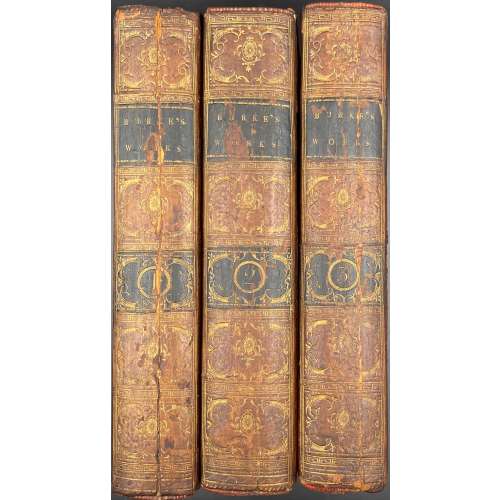 Vol. 1: THE | WORKS | OF THE | RIGHT HONOURABLE | EDMUND BURKE, | COLLECTED IN THREE VOLUMES. | VOL. I. | DUBLIN: | PRINTED FOR R. CROSS, W. WILSON, P. WO-| GAN, L. WHITE, P. BYRNE, A. GRUEBER, J. MOORE, | W. JONES, W. M’KENZIE, H. WATTS, J. RICE, | AND G. FOLINGSBY. | 1792.|| Pagination: 2 blank leaves, [2] - t.p. /blank, [2] - contents / blank, [2] - f.t. / blank, [3] 4-61 [62] - blank, [2] - f.t / blank, [4] contents, 65-580, 1 blank leaf. Collation: 8vo; π2 B-Z8 Aa-Oo8 Pp4. Vol. 2: THE | WORKS | OF THE | RIGHT HONOURABLE | EDMUND BURKE, | COLLECTED IN THREE VOLUMES. | VOL. II. | DUBLIN: | Printed by William Porter, | For R. Cross, W. Wilson, P. Wogan, L. White, P. Byrne, W. M’kenzie, J. Moore, A. Grueber, W. Jones, H. Watts, J. Rice, And G. Folingsby. | M.DCC.XCIII.|| Pagination: 2 blank leaves, [2] - t.p. /blank, [2] - contents / cont., [2] - f.t. / blank, [3] 4-655 [656 blank], 2 blank leaves. Collation: 8vo; π2 B-Z8 Aa-Tt8. Vol. 3: THE | WORKS | OF THE | RIGHT HONOURABLE | EDMUND BURKE, | COLLECTED IN THREE VOLUMES. | VOL. III. | DUBLIN: | PRINTED FOR R. CROSS, W. WILSON, P. WO-| GAN, L. WHITE, P. BYRNE, A. GRUEBER, J. MOORE, | W. JONES, W. M’KENZIE, H. WATTS, J. RICE, | AND G. FOLINGSBY. | 1792.|| Pagination: 2 blank leaves, [2] - t.p. /blank, [2] - contents / blank, [2] - f.t. / blank, 3-602, 3 blank leaves. Collation: 8vo; A-Z8 Aa-Pp8. Binding: Full contemporary calf ruled in gilt, leather spine labels gilt, gilt scrollwork in compartments framed in Greek–key rolls, marbled endpapers, hinges cracked, central vertical split to spine panel to vol. 1 and 3, early ownership signature to titles.
Vol. 1: THE | WORKS | OF THE | RIGHT HONOURABLE | EDMUND BURKE, | COLLECTED IN THREE VOLUMES. | VOL. I. | DUBLIN: | PRINTED FOR R. CROSS, W. WILSON, P. WO-| GAN, L. WHITE, P. BYRNE, A. GRUEBER, J. MOORE, | W. JONES, W. M’KENZIE, H. WATTS, J. RICE, | AND G. FOLINGSBY. | 1792.|| Pagination: 2 blank leaves, [2] - t.p. /blank, [2] - contents / blank, [2] - f.t. / blank, [3] 4-61 [62] - blank, [2] - f.t / blank, [4] contents, 65-580, 1 blank leaf. Collation: 8vo; π2 B-Z8 Aa-Oo8 Pp4. Vol. 2: THE | WORKS | OF THE | RIGHT HONOURABLE | EDMUND BURKE, | COLLECTED IN THREE VOLUMES. | VOL. II. | DUBLIN: | Printed by William Porter, | For R. Cross, W. Wilson, P. Wogan, L. White, P. Byrne, W. M’kenzie, J. Moore, A. Grueber, W. Jones, H. Watts, J. Rice, And G. Folingsby. | M.DCC.XCIII.|| Pagination: 2 blank leaves, [2] - t.p. /blank, [2] - contents / cont., [2] - f.t. / blank, [3] 4-655 [656 blank], 2 blank leaves. Collation: 8vo; π2 B-Z8 Aa-Tt8. Vol. 3: THE | WORKS | OF THE | RIGHT HONOURABLE | EDMUND BURKE, | COLLECTED IN THREE VOLUMES. | VOL. III. | DUBLIN: | PRINTED FOR R. CROSS, W. WILSON, P. WO-| GAN, L. WHITE, P. BYRNE, A. GRUEBER, J. MOORE, | W. JONES, W. M’KENZIE, H. WATTS, J. RICE, | AND G. FOLINGSBY. | 1792.|| Pagination: 2 blank leaves, [2] - t.p. /blank, [2] - contents / blank, [2] - f.t. / blank, 3-602, 3 blank leaves. Collation: 8vo; A-Z8 Aa-Pp8. Binding: Full contemporary calf ruled in gilt, leather spine labels gilt, gilt scrollwork in compartments framed in Greek–key rolls, marbled endpapers, hinges cracked, central vertical split to spine panel to vol. 1 and 3, early ownership signature to titles. -
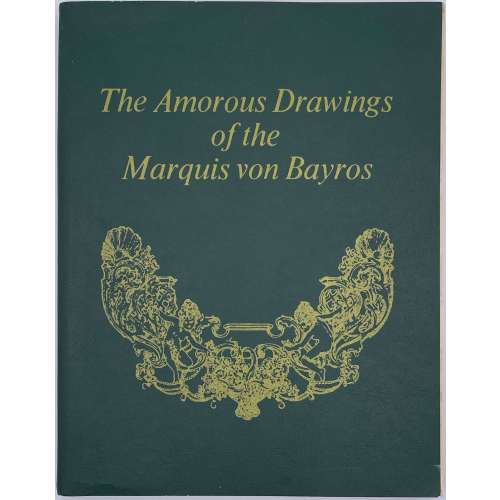 Title: The amorous drawings | {vignette} | of the | Marquis von Bayros | Part I | BRANDON HOUSE | NORTH HOLLYWOOD || Title page verso: A BRANDON HOUSE BOOK | PUBLISHED BY ARRANGEMENT WITH | CYTHERA PRESS | COPYRIGHT 1968 BY CYTHERA PRESS | ALL RIGHTS RESERVED. | MANUFACTURED IN THE UNITED STATES OF AMERICA || Pagination: [1-3] 4-238 [2], 292 illustrations within pagination. Content: Preface by Wilhelm M. Busch, biography of Von Bayros by Johann Pilz, two essays by Von Bayros; 292 illustrations by Marquis Franz von Bayros; Part I and II in one volume. Exterior: 28 x 22 cm, publisher's green wrappers with yellow lettering and fac-simile drawing of von Bayros to cover, lettering to spine. A re-print softcover edition of the original Cythera Press 1st edition, see: LIB-2246.2019
Title: The amorous drawings | {vignette} | of the | Marquis von Bayros | Part I | BRANDON HOUSE | NORTH HOLLYWOOD || Title page verso: A BRANDON HOUSE BOOK | PUBLISHED BY ARRANGEMENT WITH | CYTHERA PRESS | COPYRIGHT 1968 BY CYTHERA PRESS | ALL RIGHTS RESERVED. | MANUFACTURED IN THE UNITED STATES OF AMERICA || Pagination: [1-3] 4-238 [2], 292 illustrations within pagination. Content: Preface by Wilhelm M. Busch, biography of Von Bayros by Johann Pilz, two essays by Von Bayros; 292 illustrations by Marquis Franz von Bayros; Part I and II in one volume. Exterior: 28 x 22 cm, publisher's green wrappers with yellow lettering and fac-simile drawing of von Bayros to cover, lettering to spine. A re-print softcover edition of the original Cythera Press 1st edition, see: LIB-2246.2019 -
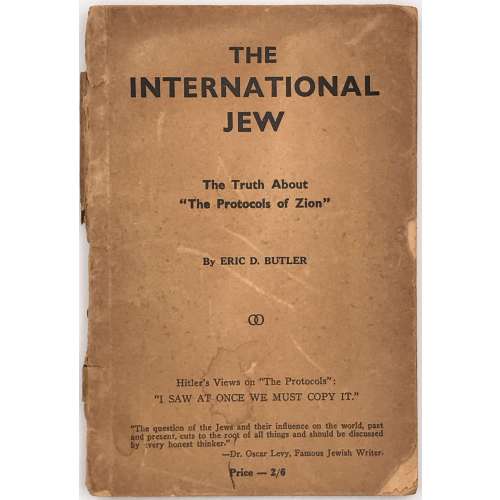 Front wrapper and t.p.: THE | INTERNATIONAL | JEW | The Truth About | "The Protocols of Zion" | By ERIC D. BUTLER | ∞ | Hitler’s Views on “The Protocols”: | “I SAW AT ONCE WE MUST COPY IT.” | “The question of the Jews and their influence on the world, past and present, cuts to the root of all things and should be discussed by every honest thinker” | — Dr. Oscar Levy, Famous Jewish Writer. | Price — 2/6 || (T.p.: same with the full stop (.) after 2/6. Stamp to t.p.: Women’s Voice | 537 SO. DEARBORN ST. | ROOM 800 | CHICAGO 5. ILL. || [2] 3-167 [168]. Binding: Lettered publisher’s wrappers, 18 x 12 cm. Butler, Eric Dudley (Australian, 1916 – 2006) Osborne, Robert Martin (British-Australian, 1862 – 1931) — Australian printer and publisher. Levy, Oscar (German-Jewish, 1867 – 1946) Hitler, Adolf (German, 1889 – 1945)
Front wrapper and t.p.: THE | INTERNATIONAL | JEW | The Truth About | "The Protocols of Zion" | By ERIC D. BUTLER | ∞ | Hitler’s Views on “The Protocols”: | “I SAW AT ONCE WE MUST COPY IT.” | “The question of the Jews and their influence on the world, past and present, cuts to the root of all things and should be discussed by every honest thinker” | — Dr. Oscar Levy, Famous Jewish Writer. | Price — 2/6 || (T.p.: same with the full stop (.) after 2/6. Stamp to t.p.: Women’s Voice | 537 SO. DEARBORN ST. | ROOM 800 | CHICAGO 5. ILL. || [2] 3-167 [168]. Binding: Lettered publisher’s wrappers, 18 x 12 cm. Butler, Eric Dudley (Australian, 1916 – 2006) Osborne, Robert Martin (British-Australian, 1862 – 1931) — Australian printer and publisher. Levy, Oscar (German-Jewish, 1867 – 1946) Hitler, Adolf (German, 1889 – 1945) -
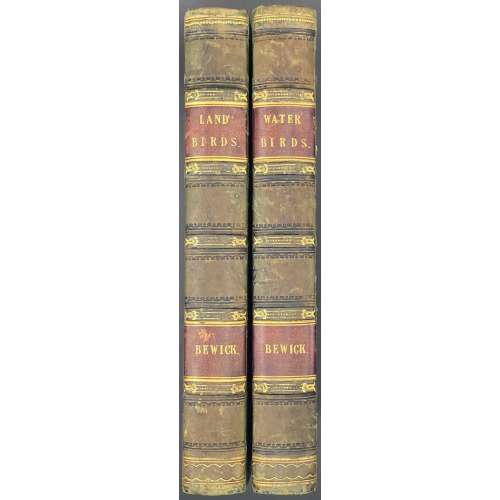 Volume 1: Land birds – 7th edition; Supplement: 1st edition. Title: A | HISTORY | OF | BRITISH BIRDS. | THE FIGURES ENGRAVED ON WOOD BY T. BEWICK. | VOL. I. | CONTAINING THE | HISTORY AND DESCRIPTION OF LAND BIRDS | — | AND | A SUPPLEMENT, WITH ADDITIONAL FIGURES. | — | NEWCASTLE: | PRINTED BY EDWARD WALKER, PILGRIM STREET, | FOR T. BEWICK : SOLD BY HIM, AND E. CHARNLEY, NEWCASTLE ; | AND LONGMAN AND CO. LONDON. | 1821. || Pagination: [2 blanks], [i, ii] – t.p. / blank, [iii] iv-xl, [43] 44-330, [2] – suppl. t.p. / blank, [1] 2-46 [47] – contents, [48] – advert., [2 blanks]. Collation: 8vo in fours; π1 A-C4 E3 F-2S4 π1 B-G4; I2, N2, and 2A2 unsigned. Woodcuts: 157 descriptions of birds, 140 figures of birds, 127 vignettes, tail-pieces, figures in text, etc. Volume 2: Water birds – 5th edition; Supplement: 1st edition. Title: A | HISTORY | OF | BRITISH BIRDS. | THE FIGURES ENGRAVED ON WOOD BY T. BEWICK. | VOL. II. | CONTAINING THE | HISTORY AND DESCRIPTION OF WATER BIRDS | — | AND | A SUPPLEMENT, WITH ADDITIONAL FIGURES. | — | NEWCASTLE: | PRINTED BY EDWARD WALKER, PILGRIM STREET, | FOR T. BEWICK : SOLD BY HIM, AND E. CHARNLEY, NEWCASTLE ; | AND LONGMAN AND CO. LONDON. | 1821. || Pagination: [2 blanks], [i, ii] – t.p. / blank, [iii] iv-xxii, [19] 20-360, [2] – suppl. t.p. / blank, [1] 2-43 [44] – contents, [1] 2-7 – addenda., [8] – imprint, [2 blanks]. Collation: 8vo in fours; π1 A-B4 *B2 C-2X4 2Y3 π1 B-F4 G2 [H]4; E2, F2, G2, 2G2, 2T2 and Suppl. G2 and Addenda unsigned. Woodcuts: 162 descriptions of birds, 125 figures of birds, 137 vignettes, tail-pieces, figures in text, etc. Both volumes: Size: 21.3 x 14 cm; page: 20.7 x 13.1 cm, demy. Binding: Green half-calf over marbled boards, blind-ruled raised bands with gilt ornament, crimson gilt-ruled and lettered labels to spine. For the first edition see: LIB-2614.2021 Catalogue raisonné: Hugo (1866): № (99) 94 –120 (108) / pp. 40-58; Roscoe (1953): № 24 a-c, 25 a-c, 26 a-c, 27 a-c, 28 / pp. 104 - 114.
Volume 1: Land birds – 7th edition; Supplement: 1st edition. Title: A | HISTORY | OF | BRITISH BIRDS. | THE FIGURES ENGRAVED ON WOOD BY T. BEWICK. | VOL. I. | CONTAINING THE | HISTORY AND DESCRIPTION OF LAND BIRDS | — | AND | A SUPPLEMENT, WITH ADDITIONAL FIGURES. | — | NEWCASTLE: | PRINTED BY EDWARD WALKER, PILGRIM STREET, | FOR T. BEWICK : SOLD BY HIM, AND E. CHARNLEY, NEWCASTLE ; | AND LONGMAN AND CO. LONDON. | 1821. || Pagination: [2 blanks], [i, ii] – t.p. / blank, [iii] iv-xl, [43] 44-330, [2] – suppl. t.p. / blank, [1] 2-46 [47] – contents, [48] – advert., [2 blanks]. Collation: 8vo in fours; π1 A-C4 E3 F-2S4 π1 B-G4; I2, N2, and 2A2 unsigned. Woodcuts: 157 descriptions of birds, 140 figures of birds, 127 vignettes, tail-pieces, figures in text, etc. Volume 2: Water birds – 5th edition; Supplement: 1st edition. Title: A | HISTORY | OF | BRITISH BIRDS. | THE FIGURES ENGRAVED ON WOOD BY T. BEWICK. | VOL. II. | CONTAINING THE | HISTORY AND DESCRIPTION OF WATER BIRDS | — | AND | A SUPPLEMENT, WITH ADDITIONAL FIGURES. | — | NEWCASTLE: | PRINTED BY EDWARD WALKER, PILGRIM STREET, | FOR T. BEWICK : SOLD BY HIM, AND E. CHARNLEY, NEWCASTLE ; | AND LONGMAN AND CO. LONDON. | 1821. || Pagination: [2 blanks], [i, ii] – t.p. / blank, [iii] iv-xxii, [19] 20-360, [2] – suppl. t.p. / blank, [1] 2-43 [44] – contents, [1] 2-7 – addenda., [8] – imprint, [2 blanks]. Collation: 8vo in fours; π1 A-B4 *B2 C-2X4 2Y3 π1 B-F4 G2 [H]4; E2, F2, G2, 2G2, 2T2 and Suppl. G2 and Addenda unsigned. Woodcuts: 162 descriptions of birds, 125 figures of birds, 137 vignettes, tail-pieces, figures in text, etc. Both volumes: Size: 21.3 x 14 cm; page: 20.7 x 13.1 cm, demy. Binding: Green half-calf over marbled boards, blind-ruled raised bands with gilt ornament, crimson gilt-ruled and lettered labels to spine. For the first edition see: LIB-2614.2021 Catalogue raisonné: Hugo (1866): № (99) 94 –120 (108) / pp. 40-58; Roscoe (1953): № 24 a-c, 25 a-c, 26 a-c, 27 a-c, 28 / pp. 104 - 114. -
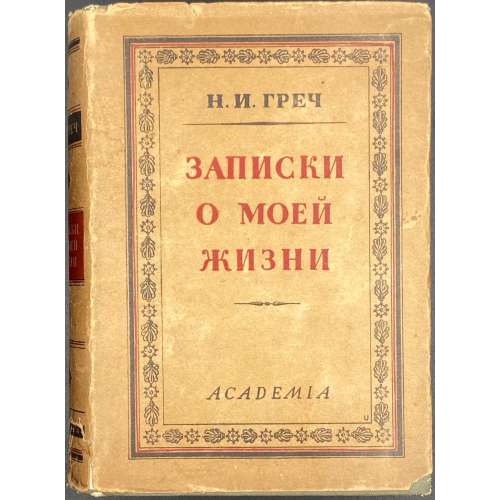 DJ: Н. И. ГРЕЧ | ЗАПИСКИ | О МОЕЙ ЖИЗНИ | ACADEMIA || Duplicate title: ПАМЯТНИКИ | ЛИТЕРАТУРНОГО | БЫТА | ЗАПИСКИ О МОЕЙ ЖИЗНИ | Н. И. ГРЕЧА | «ACADEMIA» | МОСКВА — ЛЕНИНГРАД | MCMXXX || Title page: Н. И. ГРЕЧ | ЗАПИСКИ | О МОЕЙ ЖИЗНИ | ТЕКСТ ПО РУКОПИСИ | ПОД РЕДАКЦИЕЙ | И С КОММЕНТАРИЯМИ | ИВАНОВА-РАЗУМНИКА | И Д. М. ПИНЕСА | «ACADEMIA» | МОСКВА — ЛЕНИНГРАД | MCMXXX || Title verso: ПЕРЕПЛЕТ | И СУПЕР-ОБЛОЖКА ПО РИСУНКАМ | ХУД. А. А. УШИНА | {imprint} || Pagination: [1-5] 6-896; illustrations within pagination + photomechanical frontispiece w/guard. Collation: 8vo; 1-568 (total 448 leaves + 1 plate). Binding: 18.5 x 13 cm; stamped green cloth, border to boards, elements and lettering to spine; letterpress dust jacket. Print run: 5070 copies. Catalogue raisonné: Крылов-Кичатова (2004): №402, p. 210. Contributors: Греч, Николай Иванович (Russian, 1787 – 1867) – author. Иванов-Разумник, Разумник Васильевич [Ivanov-Razoumnik] (Russian, 1878 – 1946) – editor, commentator. Пинес Дмитрий Михайлович (Russian, 1891-1937) – editor, commentator, shot by a firing squad. Ушин, Алексей Алексеевич (Russian, 1904 – 1942) – artist, died in the besieged Leningrad.
DJ: Н. И. ГРЕЧ | ЗАПИСКИ | О МОЕЙ ЖИЗНИ | ACADEMIA || Duplicate title: ПАМЯТНИКИ | ЛИТЕРАТУРНОГО | БЫТА | ЗАПИСКИ О МОЕЙ ЖИЗНИ | Н. И. ГРЕЧА | «ACADEMIA» | МОСКВА — ЛЕНИНГРАД | MCMXXX || Title page: Н. И. ГРЕЧ | ЗАПИСКИ | О МОЕЙ ЖИЗНИ | ТЕКСТ ПО РУКОПИСИ | ПОД РЕДАКЦИЕЙ | И С КОММЕНТАРИЯМИ | ИВАНОВА-РАЗУМНИКА | И Д. М. ПИНЕСА | «ACADEMIA» | МОСКВА — ЛЕНИНГРАД | MCMXXX || Title verso: ПЕРЕПЛЕТ | И СУПЕР-ОБЛОЖКА ПО РИСУНКАМ | ХУД. А. А. УШИНА | {imprint} || Pagination: [1-5] 6-896; illustrations within pagination + photomechanical frontispiece w/guard. Collation: 8vo; 1-568 (total 448 leaves + 1 plate). Binding: 18.5 x 13 cm; stamped green cloth, border to boards, elements and lettering to spine; letterpress dust jacket. Print run: 5070 copies. Catalogue raisonné: Крылов-Кичатова (2004): №402, p. 210. Contributors: Греч, Николай Иванович (Russian, 1787 – 1867) – author. Иванов-Разумник, Разумник Васильевич [Ivanov-Razoumnik] (Russian, 1878 – 1946) – editor, commentator. Пинес Дмитрий Михайлович (Russian, 1891-1937) – editor, commentator, shot by a firing squad. Ушин, Алексей Алексеевич (Russian, 1904 – 1942) – artist, died in the besieged Leningrad. -
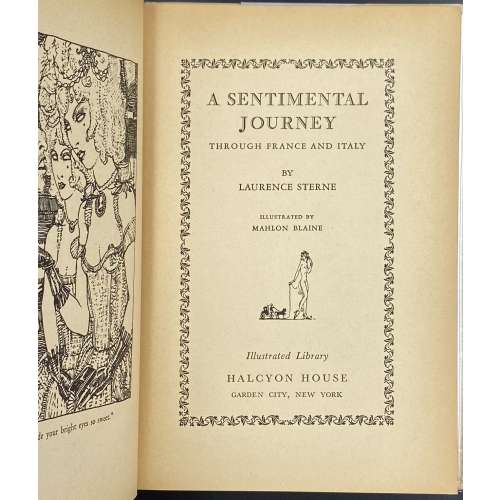 Title: A SENTIMENTAL | JOURNEY | THROUGH FRANCE AND ITALY | BY | LAURENCE STERNE | ILLUSTRATED BY | MAHLON BLAINE | {vignette} | Illustrated library | HALCYON HOUSE | GARDEN CITY, NEW YORK || Pagination: [1-6] – first leaf blank, h.t., t.p., 7-192, total 192 pages; frontispiece plus 4 plates within collation, and a headpiece, all photomechanical reproductions of Mahlon Blaine’s pen drawings. Binding: 20.5 x 14 cm, off-white pictorial paper boards decorated with black ivy-clad pink lattice, black lettering in a pink frame to spine, pink pictorial dust jacket with spine sunned to beige. Contributors: Sterne, Laurence (British-Irish, 1713 – 1768) – author of the text. Blaine, Mahlon (American, 1894 – 1969) – illustrator (pseudonym: G. Christopher Hudson). The Illustrated library series was started by Halcyon House, a reprint division of Doubleday Publishers, in 1950. This edition of Sterne with Blaine’s illustrations is a reprint of the same, published by Three Sirens Press of New York in 1930. Blaine's illustrations of this kind are pen drawings, not wood engravings.
Title: A SENTIMENTAL | JOURNEY | THROUGH FRANCE AND ITALY | BY | LAURENCE STERNE | ILLUSTRATED BY | MAHLON BLAINE | {vignette} | Illustrated library | HALCYON HOUSE | GARDEN CITY, NEW YORK || Pagination: [1-6] – first leaf blank, h.t., t.p., 7-192, total 192 pages; frontispiece plus 4 plates within collation, and a headpiece, all photomechanical reproductions of Mahlon Blaine’s pen drawings. Binding: 20.5 x 14 cm, off-white pictorial paper boards decorated with black ivy-clad pink lattice, black lettering in a pink frame to spine, pink pictorial dust jacket with spine sunned to beige. Contributors: Sterne, Laurence (British-Irish, 1713 – 1768) – author of the text. Blaine, Mahlon (American, 1894 – 1969) – illustrator (pseudonym: G. Christopher Hudson). The Illustrated library series was started by Halcyon House, a reprint division of Doubleday Publishers, in 1950. This edition of Sterne with Blaine’s illustrations is a reprint of the same, published by Three Sirens Press of New York in 1930. Blaine's illustrations of this kind are pen drawings, not wood engravings. -
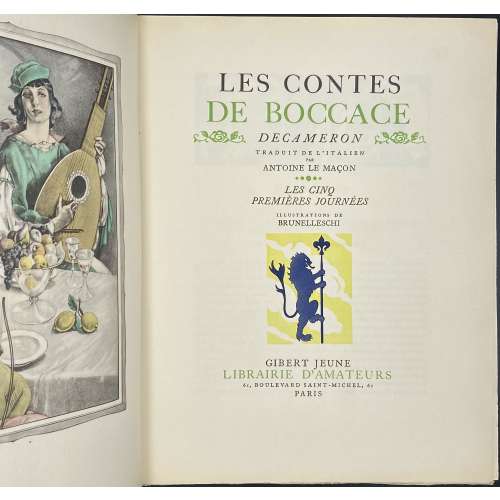 Vol. 1: Front cover and title page: LES CONTES | DE BOCCACE | ☙ DECAMERON ❧ | TRADUIT DE L'ITALIEN | PAR | ANTOINE LE MAÇON | LES CINQ | PREMIÈRES JOURNÉES | ILLUSTRATIONS DE | BRUNELLESCHI | {vignette} | GIBERT JEUNE | LIBRAIRIE D'AMATEURS | 61, BOULEVARD SAINT-MICHEL, 61 | PARIS || Pagination: [6] 1-342 [343-4] [10], 16 colour plates and 70 b/w head- and tailpieces after Umberto Brunelleschi. Vol. 2: Front cover and title page: LES CONTES | DE BOCCACE | ☙ DECAMERON ❧ | TRADUIT DE L'ITALIEN | PAR | ANTOINE LE MAÇON | LES CINQ | DERNIÈRES JOURNÉES | ILLUSTRATIONS DE | BRUNELLESCHI | {vignette} | GIBERT JEUNE | LIBRAIRIE D'AMATEURS | 61, BOULEVARD SAINT-MICHEL, 61 | PARIS || Pagination: [6] 1-281 [282] [10], 16 colour plates and 68 b/w head- and tailpieces after Umberto Brunelleschi. Edition: Limited to 2,500 copies, of which this is № 1. Edition supplemented with two full extra sets of plates, 32 in black and white, and 32 in colour. Printed on June 25, 1934. Binding: 26.5 x 20.5 cm; cream flapped wrappers (French softcover) with green and black lettering and vignettes to front cover and spine, publisher’s device on the back; uncut copy. Paper: Vélin de Navarre (wove paper), size: 260 x 200 mm. Contributors: Giovanni Boccaccio (Italian, 1313 – 1375) – author. Antoine Le Maçon (French, c. 1500 – 1559) – translator. Umberto Brunelleschi (Italian, 1879 – 1949) – artist. Malexis, Louis (French, 20 century) – mise en page. Coulouma, Robert (French, 1887 – 1976), Imprimerie Coulouma (Argenteuil) – printer, H. Barthélemy – director. Dantan, A. – engraver (probably from the family of Edouard Joseph Dantan (French, 1848 – 1897) Charpentier, E. – colour au pochoir. Compare this copy with a small one-volume reprint of 1941: [LIB-2773.2021]. Description of the stensil (au pochoir) technique.
Vol. 1: Front cover and title page: LES CONTES | DE BOCCACE | ☙ DECAMERON ❧ | TRADUIT DE L'ITALIEN | PAR | ANTOINE LE MAÇON | LES CINQ | PREMIÈRES JOURNÉES | ILLUSTRATIONS DE | BRUNELLESCHI | {vignette} | GIBERT JEUNE | LIBRAIRIE D'AMATEURS | 61, BOULEVARD SAINT-MICHEL, 61 | PARIS || Pagination: [6] 1-342 [343-4] [10], 16 colour plates and 70 b/w head- and tailpieces after Umberto Brunelleschi. Vol. 2: Front cover and title page: LES CONTES | DE BOCCACE | ☙ DECAMERON ❧ | TRADUIT DE L'ITALIEN | PAR | ANTOINE LE MAÇON | LES CINQ | DERNIÈRES JOURNÉES | ILLUSTRATIONS DE | BRUNELLESCHI | {vignette} | GIBERT JEUNE | LIBRAIRIE D'AMATEURS | 61, BOULEVARD SAINT-MICHEL, 61 | PARIS || Pagination: [6] 1-281 [282] [10], 16 colour plates and 68 b/w head- and tailpieces after Umberto Brunelleschi. Edition: Limited to 2,500 copies, of which this is № 1. Edition supplemented with two full extra sets of plates, 32 in black and white, and 32 in colour. Printed on June 25, 1934. Binding: 26.5 x 20.5 cm; cream flapped wrappers (French softcover) with green and black lettering and vignettes to front cover and spine, publisher’s device on the back; uncut copy. Paper: Vélin de Navarre (wove paper), size: 260 x 200 mm. Contributors: Giovanni Boccaccio (Italian, 1313 – 1375) – author. Antoine Le Maçon (French, c. 1500 – 1559) – translator. Umberto Brunelleschi (Italian, 1879 – 1949) – artist. Malexis, Louis (French, 20 century) – mise en page. Coulouma, Robert (French, 1887 – 1976), Imprimerie Coulouma (Argenteuil) – printer, H. Barthélemy – director. Dantan, A. – engraver (probably from the family of Edouard Joseph Dantan (French, 1848 – 1897) Charpentier, E. – colour au pochoir. Compare this copy with a small one-volume reprint of 1941: [LIB-2773.2021]. Description of the stensil (au pochoir) technique. -
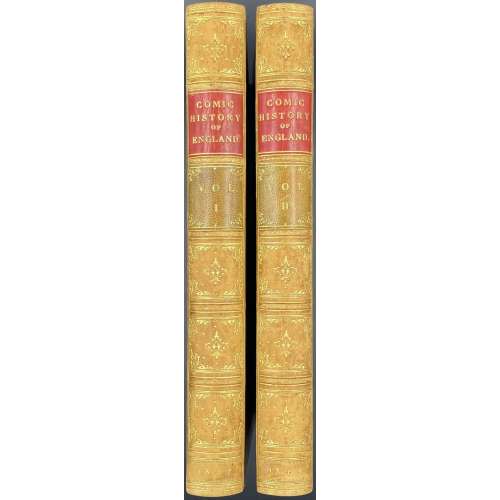 Vol. 1: Title page (red and black): THE | COMIC HISTORY OF ENGLAND • | BY GILBERT ABBOTT A'BECKETT. | {vignette with one line caption} | WITH TEN COLOURED ETCHINGS AND ONE HUNDRED AND TWENTY | WOODCUTS, | BY JOHN LEECH. | VOL. I. | PUBLISHED AT THE PUNCH OFFICE, 85, FLEET STREET. | MDCCCXLVII. || Pagination: [iii-iv] – t.p. / imprint., [v]-vi – preface, [vii]-viii – contents, [ix]-xii – list of ills. [1] 2-320, lacking half-title otherwise as called for by Tooley (1935) p. 161. Collation: 8vo; π3 b2 B-X8 plus 10 plates, incl. frontispiece, of hand-coloured steel engravings and 120 in-text woodcuts by John Leech. Vol. 2: Title page: similar but “VOL. II.” And “MDCCCXLVIII”; typeface “with ten coloured…” is different (sans serif). Pagination: [iii-iv] – t.p. / imprint., [v]-vi – advert., [vii]-viii – contents, [ix]-xii – list of ills. [1] 2-304, lacking half-title otherwise as called for by Tooley (1935) p. 161. Collation: 8vo; π3 b2 B-U8 X2 plus 10 plates, incl. frontispiece, of hand-coloured steel engravings and 120 in-text woodcuts by John Leech. Binding: two volumes 22 x 14.5 cm each uniformly bound in full tan calf with gilt double-fillet border, spine gilt in compartments with red and green morocco labels lettered in gilt, blind-stamped dentelle inside, blue marbled endpapers, all edges marbled, additional flyleafs at the front and end. Catalogue raisonné: Hardie p. 210-11; Abbey, Life № 434, p. 362; Tooley (1935) p. 161 Contributors: Gilbert Abbott à Beckett (British, 1811 – 1856) – author. John Leech (British, 1817 – 1864) – artist. Bradbury & Evans (Whitefriars); William Bradbury (British, 1799 – 1869); Frederick Mullett Evans (British, 1804 – 1870) – printer. Punch – publisher.
Vol. 1: Title page (red and black): THE | COMIC HISTORY OF ENGLAND • | BY GILBERT ABBOTT A'BECKETT. | {vignette with one line caption} | WITH TEN COLOURED ETCHINGS AND ONE HUNDRED AND TWENTY | WOODCUTS, | BY JOHN LEECH. | VOL. I. | PUBLISHED AT THE PUNCH OFFICE, 85, FLEET STREET. | MDCCCXLVII. || Pagination: [iii-iv] – t.p. / imprint., [v]-vi – preface, [vii]-viii – contents, [ix]-xii – list of ills. [1] 2-320, lacking half-title otherwise as called for by Tooley (1935) p. 161. Collation: 8vo; π3 b2 B-X8 plus 10 plates, incl. frontispiece, of hand-coloured steel engravings and 120 in-text woodcuts by John Leech. Vol. 2: Title page: similar but “VOL. II.” And “MDCCCXLVIII”; typeface “with ten coloured…” is different (sans serif). Pagination: [iii-iv] – t.p. / imprint., [v]-vi – advert., [vii]-viii – contents, [ix]-xii – list of ills. [1] 2-304, lacking half-title otherwise as called for by Tooley (1935) p. 161. Collation: 8vo; π3 b2 B-U8 X2 plus 10 plates, incl. frontispiece, of hand-coloured steel engravings and 120 in-text woodcuts by John Leech. Binding: two volumes 22 x 14.5 cm each uniformly bound in full tan calf with gilt double-fillet border, spine gilt in compartments with red and green morocco labels lettered in gilt, blind-stamped dentelle inside, blue marbled endpapers, all edges marbled, additional flyleafs at the front and end. Catalogue raisonné: Hardie p. 210-11; Abbey, Life № 434, p. 362; Tooley (1935) p. 161 Contributors: Gilbert Abbott à Beckett (British, 1811 – 1856) – author. John Leech (British, 1817 – 1864) – artist. Bradbury & Evans (Whitefriars); William Bradbury (British, 1799 – 1869); Frederick Mullett Evans (British, 1804 – 1870) – printer. Punch – publisher. -
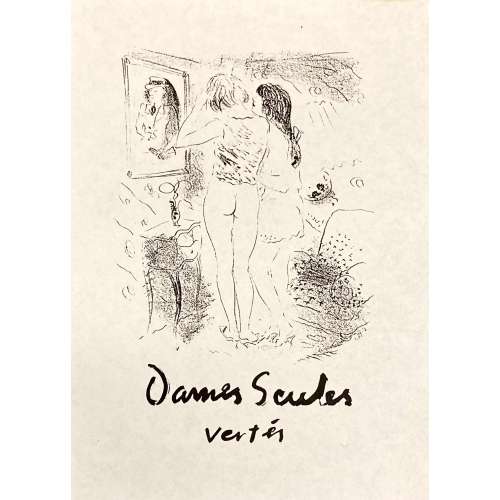 1st edition, limited to 52 copies of which 7 copies on Japon paper (№ 1-7) and 45 copies on Rives paper (№ 8-52); printed by Maurice Daratiere; this copy is № 50. “Ladies only” – a pictorial album, unbound, printed by Maurice Darantiere, with 15 black and white lithographs by Edouard Duchâtel (French, 19th-20th century) after drawings by Marcel Vertès on cream wove paper 38 x 28 cm; French flapped wrappers, with the lithographed manuscript title “Dames seules” in a grey clamshell box 40 x 30 cm; printed by Maurice Darantiere, title with vignette pasted to box cover, one image on a double sheet; all illustrations with tissue guards. Bookplate “From the Library of | Vance Gerry | The Weather Bird Press | pasted inside the box cover (see Vance Gerry and The Weather Bird Press). Provenance: Vance Bryden Gerry (American, 1929 – 2005) Contributors: Marcel Vertès [Marcell Vértes] (Jewish-Hungarian-French, 1895 – 1961) – artist. Francis Carco [François Carcopino-Tusoli] (French, 1886 – 1958) – author. Edouard Duchâtel (French, 19th-20th century) – artist, lithographer. Maurice Darantiere (French, 1882 – 1962) – printer. Louis Godefroy (French, 1885 – 1934) – publisher. Other names: Marcel Vertès, Marcel Vertes, Marcell Vértes
1st edition, limited to 52 copies of which 7 copies on Japon paper (№ 1-7) and 45 copies on Rives paper (№ 8-52); printed by Maurice Daratiere; this copy is № 50. “Ladies only” – a pictorial album, unbound, printed by Maurice Darantiere, with 15 black and white lithographs by Edouard Duchâtel (French, 19th-20th century) after drawings by Marcel Vertès on cream wove paper 38 x 28 cm; French flapped wrappers, with the lithographed manuscript title “Dames seules” in a grey clamshell box 40 x 30 cm; printed by Maurice Darantiere, title with vignette pasted to box cover, one image on a double sheet; all illustrations with tissue guards. Bookplate “From the Library of | Vance Gerry | The Weather Bird Press | pasted inside the box cover (see Vance Gerry and The Weather Bird Press). Provenance: Vance Bryden Gerry (American, 1929 – 2005) Contributors: Marcel Vertès [Marcell Vértes] (Jewish-Hungarian-French, 1895 – 1961) – artist. Francis Carco [François Carcopino-Tusoli] (French, 1886 – 1958) – author. Edouard Duchâtel (French, 19th-20th century) – artist, lithographer. Maurice Darantiere (French, 1882 – 1962) – printer. Louis Godefroy (French, 1885 – 1934) – publisher. Other names: Marcel Vertès, Marcel Vertes, Marcell Vértes


